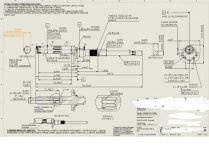Mark Winsor
Aluminum
- Joined
- Feb 4, 2013
- Location
- Hartford, CT, USA
Below drawing is for a 4140 pre-hard crankshaft, which will get Nitrided to a surface hardness of RC58 and a depth of .015"
The nitriding is required for surface hardness on two needle bearing journals which require RC58+ according to SKF.
My question is, how much is the shaft likely to bend/grow during the Nitriding process? It is 8" long and the first 2" are hollow, with just a thin outer wall. The OD of the thin part is the surface the bearing runs on.
Of course we need to leave some amount of stock on there for finish grinding after Nitride, but if too much is left, the hardness will drop off as the material is removed.
If not enough is left, the risk is the part bending to the point where it doesn't clean up.
I was going to guess to leave .005" per side on that diameter, although that's a guess, I don't have much experience with Nitriding large parts. I would prefer to leave more like .001".
Any other suggestions for how to make the part are also welcome. We are open to changing the material and process, but not dimensions. I have had bad luck in the past with through hardened crankshafts being too brittle, so I'd prefer to go with a case hardening or hardening + coating?
Thanks a lot,
Mark


The nitriding is required for surface hardness on two needle bearing journals which require RC58+ according to SKF.
My question is, how much is the shaft likely to bend/grow during the Nitriding process? It is 8" long and the first 2" are hollow, with just a thin outer wall. The OD of the thin part is the surface the bearing runs on.
Of course we need to leave some amount of stock on there for finish grinding after Nitride, but if too much is left, the hardness will drop off as the material is removed.
If not enough is left, the risk is the part bending to the point where it doesn't clean up.
I was going to guess to leave .005" per side on that diameter, although that's a guess, I don't have much experience with Nitriding large parts. I would prefer to leave more like .001".
Any other suggestions for how to make the part are also welcome. We are open to changing the material and process, but not dimensions. I have had bad luck in the past with through hardened crankshafts being too brittle, so I'd prefer to go with a case hardening or hardening + coating?
Thanks a lot,
Mark





